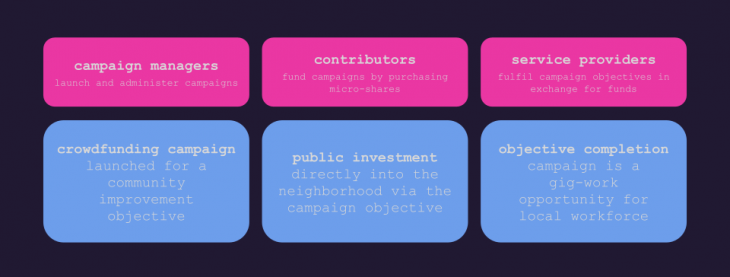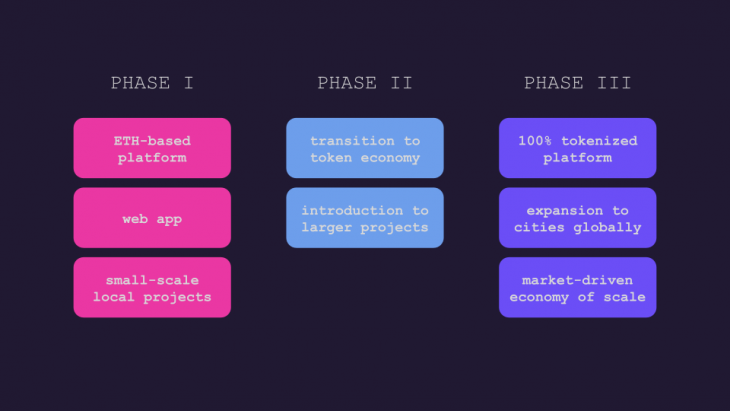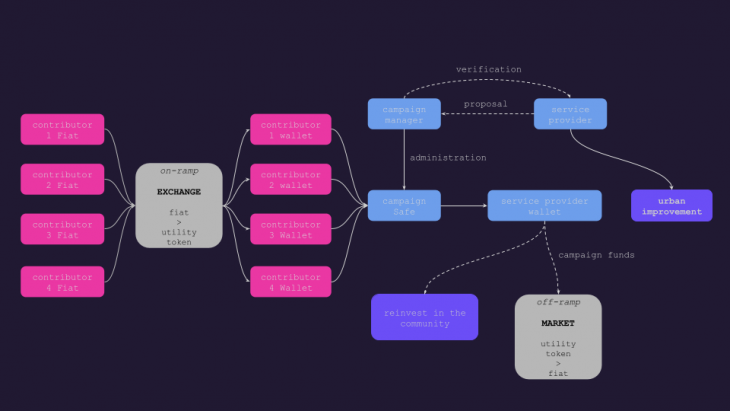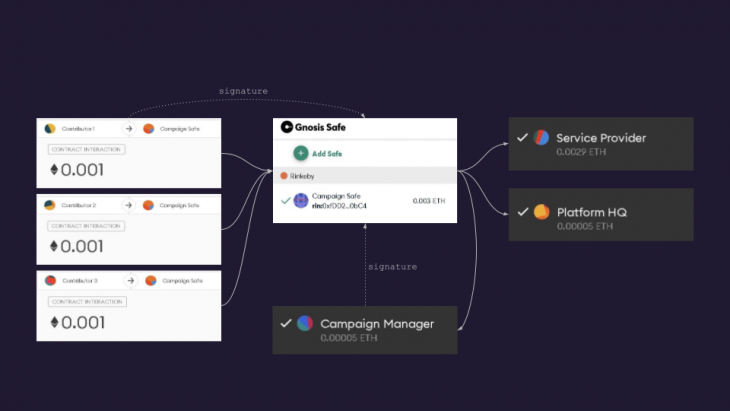Introduction
In this project, we explore how blockchain systems and cryptourbanomics could fundamentally change the way cities approach community development. We will look at our long-term vision for the project, go into how such a system could operate, and finish with a technical overview of the crypto tools involved.
Context
Around the world, millions of people are moving into cities. This great urban migration is fueling the global economy and creating unprecedented wealth, but it is also putting tremendous strain on local governments. As the ranks of newcomers join cities, they put pressure on public services as they integrate into the local economy. Cities are burdened with managing services as well as upkeep. Local governments often don’t have the ability or resources to adequately address the multitude of small and large issues that arise regularly in the evolution and maintenance of neighborhoods. The tragedy of the commons often results, in undermining the ability of local communities to build beautiful, sustainable urban environments.
The problem here is that there is often no economic incentive for the private sector to get involved. Thus the transformative power of entrepreneurship and the private sector at large rarely become involved. Helping improve the community is left to nonprofits and the intervention of the government. What if there was a way to build a system of economic incentives that unlocked the power of the private sector in improving neighborhoods? Could local laborers, professionals, and small businesses help create high-quality, beautiful, sustainable neighborhoods? We think it is possible with a creative application of cryptourbanomics.
Crowdfunding Community Development
Crypto systems could generate economic incentives for community improvement through crowdfunding. This would be a crypto-based crowdfunding platform, oriented specifically toward projects that need to be done in the local community. The platform would allow stakeholders to come together to propose, fund, and complete projects in the community that local businesses and the government would typically neglect. Projects could range anywhere from the very small scale (like a pothole that needs to be repaired), to very large scale (like an entire local library development).
Stakeholders and functionality
There are three primary stakeholders involved in such a system:
Campaign managers: any local individual or group can launch a crowdfunding campaign with a specific community improvement as its objective. Once the campaign is launched on the platform, it is open for contributions.
Project contributors: any individual or group, anywhere in the world, can invest in the campaign by purchasing micro-shares of the final neighborhood improvement. Contributors could range from individuals directly affected by the project who wish to see it come to fruition so they can enjoy the benefits, all the way to NGOs in another country altogether who may have the mission of helping to fund objectives of the specific type proposed in the campaign.
Service providers: As the fund of contributions in the campaign grows, local laborers, professionals and businesses become increasingly incentivized to offer to complete the campaign objective. In the case of a very small improvement, like filling a pothole, the campaign fund may not need to grow very large before a local laborer or business offers to complete the work in exchange for the campaign funds as a reward. In the case of a large project, like a library, the campaign funds may need time to grow quite large (involving many individual contributors as well as local businesses and organizations) before a developer would have enough incentive to build the property.

A New Gig Economy
Although the vision of developing large-scale community improvements may prove possible in the long term, most community improvements are small projects that an individual or local small business can handle. This makes the community development platform a kind of gig work economy. Up till now, the gig economy has been mostly concentrated in the digital and technical realms of professional work. Software engineers, graphic designers, and personal trainers may find it fairly easy to acquire gig work today. But most people and most professions are still nowhere near the gig economy. As software and robots cause major shifts in the jobs landscape, more and more people will be turning to gig-style work arrangements to supplement their income.
The platform we are proposing here is a mechanism to provide a social incentive for community improvements. Underneath, however, it is really the basis for a new gig economy. Every day people can find work carrying out the objectives set forth in crowdfunding campaigns. As the platform scales to cities across the globe, a market dynamic could ultimately emerge where the platform’s native utility tokens would trade with increasing value in global crypto markets. When a service provider completes a campaign objective, they may sell their tokens in the market for fiat in order to earn an income, or they may choose to keep the tokens in the platform to fund their own future campaigns as a way of acquiring services from the community that they require for their everyday life.
Implementation
Phase I: Initially, a web app would be developed as the platform’s user interface. The platform would initially launch using ETH as its native currency. The platform would be linked to a crypto exchange so that people could easily change fiat into ETH to fund their crypto wallets as they join. In this phase, the platform would focus on small-scale, local projects in the founding city.
Phase II: In phase II the platform would introduce a native utility token. Repeat campaign founders, contributors, and service providers could all begin to accept the utility token instead of ETH. During the transition, tokens could be exchanged for ETH on the platform at any time. The platform would expand into larger projects during this phase.
Phase III: In the final phase of implementation, the platform would scale globally into cities all over the world. With that expansion would come an economy of scale and drive a market value around the platform’s native utility tokens. That market value would enable the transition away from ETH into a 100% tokenized circular economy. The ultimate vision for this final phase is a circular utility token economy in which the lines between campaign founders, contributors, and service providers are blurred. In such a world, the platform’s utility token would take on a currency-like quality and encourage ongoing circularity.
Technical Prototype
For this project, we designed a system structure for the platform and executed its functionality in a technical prototype using free tools running on the Rinkeby Test Network. The platform structure brings together the three stakeholder groups in a crowdfunding format.
We demonstrated functionality by setting up a test network system. Wallets for campaign managers, contributors, service providers, and the platform were created using Metamask. A campaign safe was set up using Gnosis. The flow of capital between stakeholders is mediated by the multisig safe.
Crowdfunding Community Development is a project of IAAC, Institute for Advanced Architecture of Catalonia developed in the Master in City & Technology 2021/22 by students: Karim Abillama and Ocean Jangda and faculty: Maria-Luisa Marsal Llacuna.



